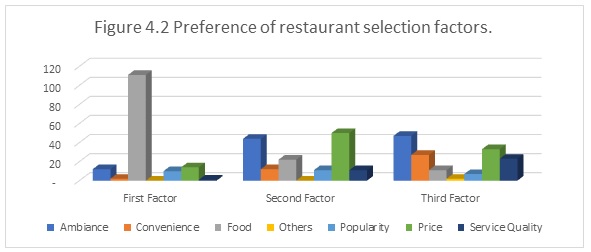Impact of Servicescape of Restaurants on Consumer Perceptions - A Study based in Kolkata
DOI:
https://doi.org/10.54741/mjar.2.6.9Keywords:
servicescape, restaurants, customer satisfaction, customer loyalty, intentionAbstract
The current study examines the relationship between the servicescape of a restaurant and its influence on customers across different restaurant settings. It seeks to study the servicescape cues that impact consumer perception and behavioural intention i.e. consumer responses. A questionnaire survey was performed for the same, among different age groups in Kolkata to gain insights about consumer perception. Results indicate that there is an inextricable link between a restaurant servicescape and consumer satisfaction. Dimensions of a servicescape that consumers perceive important came to fore and also the sensory and emotional responses.
Downloads
References
Bakker, I., Voordt, T.V.D, Vink, P., & Boon, J.D. (2014). Pleasure, arousal, dominance: Mehrabian and Russell revisited.
Bitner, M.J. (1992). ‘Servicescapes: The impact of physical surroundings on customers and employees.
Booms, B. H., & Bitner, M. J. (1982). Marketing services by managing the environment.
Bush, L.E. (1973). Journal of Personality and Social Psychology. Cornell Hospitality Quarterly.
DiPietro, R.B., & Campbell J. (2014). The influence of servicescape and local food attributes on pleasure and revisit intention in an upscale-casual dining restaurant.
Kotler, P. (1973). Atmospherics as a marketing tool. Journal of Retailing.
Lin, I.Y., & Mattila, A.S. (2010). Restaurant servicescape, service encounter, and perceived congruency on customers' emotions and satisfaction. Journal of Hospitality Marketing & Management.
Mehrabian, A. (1996). Pleasure-arousal-dominance: a general framework for describing and measuring individual differences in temperament. Current Psychology.
Mehrabian, A., & Russell, J. A (1977). Evidence for a three-factor theory of emotions.
Mehrabian, A., & Russell, J. A. (1974). An approach to environmental psychology.
Russell, J.A., & Pratt, A. (1980). A description of the affective quality attributed.
Ryu, K (2005). Dinescape, emotions and behavioural intentions in upscale restaurants.
Shashikala, R., & Suresh, A. M. (2018). Impact of servicescape on customer perceived value in fine dining restaurants.
NRAI India Food Services Report (IFSR). (2019). Retrieved from: www.foodhospitality.in/in-focus/nrai-india-food-services-report-ifsr-2019-the-sector-is-projected-to-grow-at-a-cagr-of-9-per-cent-by-2022-23/417232/ & www.hospitalitybizindia.com/detailnews.aspx?Aid=30524&sid=12 . Last accessed April 3, 2020.
www.cxservice360.com/2017/09/14/great-ambience-important-customer-experience/ Last accessed March 22, 2020.
hbr.org/1998/07/welcome-to-the-experience-economy/ Last accessed April 2, 2020.
www.pos.toasttab.com/blog/restaurant-management-statistics. Last accessed February 10, 2020.
www.superheuristics.com/core-competency-framework/ Last accessed April 2, 2020.

Published
How to Cite
Issue
Section
License
Copyright (c) 2022 Dr. Soma Nath, Riya Agarwal

This work is licensed under a Creative Commons Attribution 4.0 International License.
Research Articles in 'Management Journal for Advanced Research' are Open Access articles published under the Creative Commons CC BY License Creative Commons Attribution 4.0 International License http://creativecommons.org/licenses/by/4.0/. This license allows you to share – copy and redistribute the material in any medium or format. Adapt – remix, transform, and build upon the material for any purpose, even commercially.









